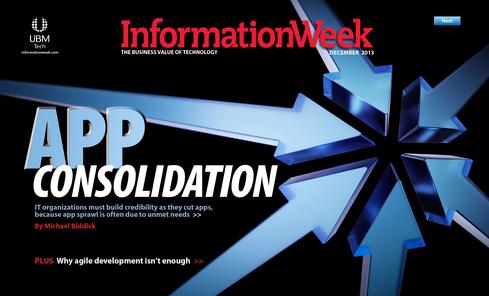App Consolidation: IT's Cred Is On The Line
IT organizations must build credibility as they cut apps, because app sprawl is often due to unmet needs.

 Download the entire December 2013 special issue of InformationWeek, distributed in an all-digital format (registration required).
Download the entire December 2013 special issue of InformationWeek, distributed in an all-digital format (registration required).
CIOs have tried to streamline their application portfolios for years, holding a particular vengeance against managing multiple systems for email, billing, CRM, business analytics, human resources, and inventory management. There is much to love about application consolidation: It promotes information sharing and interoperability, and it saves money if IT isn't supporting and licensing multiple systems that do the same job. So why is it still so hard?
Forty-five percent of companies manage multiple pieces of software that provide duplicate functionality, according to our InformationWeek Application Consolidation Survey of 169 business technology professionals. Yet only 13% of companies consolidating their app portfolios think the top barrier to doing so is that certain apps offer legitimately unique functionality.
Cloud computing is making things harder. As soon as IT organizations decommission an on-premises application, they're seeing three new cloud-based ones pop up to take its place, since it's so easy for business units and teams to grab an app to get a service they want. Same goes for mobile apps. Unless the top executives are truly committed to application consolidation, it will fail.
Over the past four years at my consulting firm, Fusion PPT, we've seen a lot of our clients tie their application consolidation efforts to their datacenter consolidation. Not so much these days, especially at big companies, however. Why? They think that consolidating applications and datacenters is just too much to tackle at once, and that app consolidation has a big enough benefit that it doesn't need to ride the datacenter's coattails.
But cutting applications stirs strong emotions. One in five respondents to our survey cites "pushback from users" as the No. 1 barrier, tied with lack of budget and limited resources. It's important for IT organizations to understand why their "application huggers" want to hang onto an app and to consider legitimate functional needs versus simple resistance to change. The most effective approach is to seek their input and feedback throughout the process, while emphasizing the executive mandate that some apps must go.
IT organizations must keep something else in mind, as well: 63% of survey respondents say the reason apps got duplicated in the first place was that the existing apps weren't meeting a specific business need. IT must cut applications while showing users that it's trying to satisfy their needs.
Consolidation: Too good to ignore
Cutting costs is the biggest reason companies consolidate applications, cited by 37% of survey respondents. It's easy to make the business case: Just add up the software license costs and the hardware, datacenter space, energy, and other expenses needed to support duplicate apps. Two harder-to-quantify benefits of a smaller app portfolio are that it makes integration and data sharing simpler, and that IT can focus more on the business applications that are core to driving revenue and increasing efficiency.
Identifying overlapping functions is hard when the applications serve different business units, however. The respondents to our survey cite billing and inventory systems as the top candidates for consolidation (selected by 18% and 17% of respondents, respectively). But no other application type (business intelligence, document management, collaboration, ERP, HR) was cited by more than 11% of respondents. And because employees perceive their apps' capabilities as unique, and because they're comfortable with them, even the thought of losing them can be terrifying, making consolidation a political battle that too many CIOs avoid. Just 12% of the IT pros in our survey say employees at their companies accept app consolidation readily, while 57% say they're uneasy and 31% say they're resistant or openly hostile. Talk about a thankless job.
To read the rest of this story,
download the December 2013 special issue of InformationWeek.
About the Author(s)
You May Also Like
How to Amplify DevOps with DevSecOps
May 22, 2024Generative AI: Use Cases and Risks in 2024
May 29, 2024Smart Service Management
June 4, 2024







